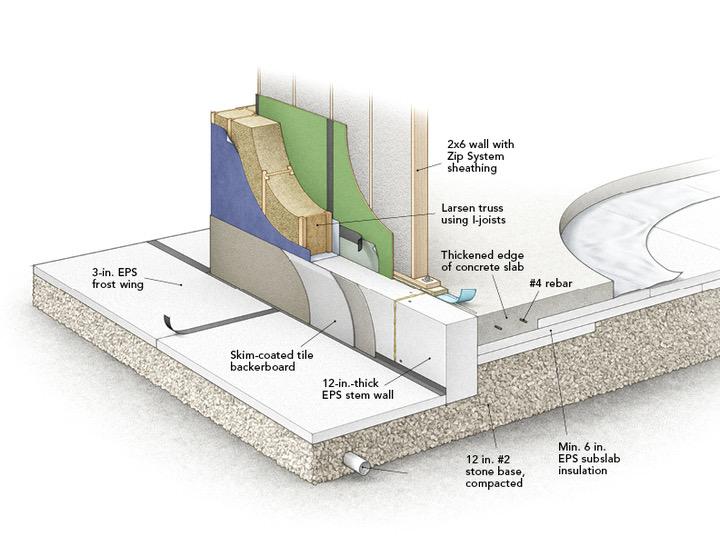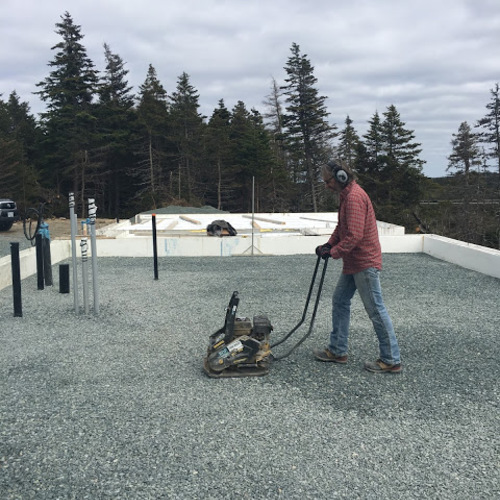
One of the most common foundations in the U.S. is a monolithic concrete turn-down slab. The beauty of this system is that the foundation wall and slab are created in one casting, which makes it efficient in terms of cost, labor, and time. One of the downsides, however, is that it can be difficult to insulate because its structural integrity relies on it being monolithic, meaning uninterrupted.
In conventional foundation systems, the slab is independent of the foundation wall, which makes it easy to incorporate the thermal boundaries within the assembly. The monolithic foundation system is not as straightforward. Because the outer edge of the slab is exposed, it includes a significant thermal bridge.
The easiest way to create a continuous thermal boundary while maintaining structural integrity is to keep the turn-down foundation outside the conditioned space. In this detail, 4 in. of expanded polystyrene foam board (EPS) is installed on top of the slab. This allows for the structural integrity of the foundation to remain intact while managing the thermal boundary for continuity. (This specific detail was designed for new construction in climate zone 5. The 4 in. of EPS can be climate-tuned to the building’s location.)
Two layers of 3/4-in. floor sheathing is installed over the rigid foam to provide for floor finishes. The top layer is installed 90° to the bottom layer, and the joints are staggered 2 ft. in both directions. This creates a 1-1/2-in. raft section of floor sheathing that is not mechanically fastened to the slab; it floats above—hence the name raft. The advantage of this approach is that the rough finish—the 3/4-in. floor sheathing—is set to receive any floor finish.
One concern for new construction is moisture migration from the new slab upward into the finished floor. After consulting with professionals in…
Weekly Newsletter
Get building science and energy efficiency advice, plus special offers, in your inbox.

This article is only available to GBA Prime Members
Sign up for a free trial and get instant access to this article as well as GBA’s complete library of premium articles and construction details.
Start Free TrialAlready a member? Log in















15 Comments
I have considered this approach for an addition, but in climate zone 6 with passive solar & wood stove heat, I will opt for insulating below the slab so the concrete will provide thermal mass. Just another tradeoff...
One complication is that the exterior walls have to be 4" higher than the interior partitions, which have to be framed after the foam and subfloor is installed.
Why
I would stand walls then fit insulation after close in 0
Four reasons:
- Cutting and fitting two layers of sub-floor and rigid insulation in a floor plan cut up by interior partitions would be substantially more work.
- Compared to a continuous sub-floor the small sections would be much less stable and able to spread loads.
- You are back to having to cut each stud individually from longer stock, rather than using pre-cut studs.
- The interior partitions represent thermal bridges.
I'd still do as you suggest and lay the sub-floor and insulation after lock-up, but with just the exterior walls up. Otherwise you risk getting the floor assembly wet, and it's one that would be difficult to get dry.
In many ways this design is easier to build or more like conventional methods than typical EPS underslab and protected slab edge insulation (except the problem Malcolm noted, which would require cutting drywall, shorter ceiling heights or longer studs). The foundation work with no edge or below slab insulation might be more acceptable to some traditional builders. Expenses go to two Advantech layers instead of slab edge insulation with protection. And no option for a tiled or polished slab instead of wood flooring.
Maybe the more labor intensive under slab and slab edge insulation complexity is only needed for buildings more highly insulated than shown in this design. (There is thermal bridging along the perimeter from the concrete edge, through bottom plates, Advantech and flooring, about R-11.)
But why not just eliminate the slab altogether, with concrete stem walls, and float the Advantech the way Steve Baczek has done (if I remember correctly)? Yes you need some foundation edge insulation, which this design avoids.
Yes I believe this method -- or something similar -- is in the most recent issue of FHB. February/March 2022 issue. The author of this piece, Josh Salinger, also discussed on a BS & Beer on concrete-free slabs: https://www.youtube.com/watch?v=iGXoAN4znTI. Baczek is also on that episode.
One potential problem with this type of design is that it has the potential to decrease concrete lifespans in cold climates due to freeze thaw cycles.
By insulating the floor, and not insulating the slab edge, you're making the concrete colder than it ever would have been without the insulation. The concrete mix design can increase the air entrainment as a precaution, but at some point you have to pay the piper.
It can't be driven over, like sub-slab insulation, which means for garages or other finished but not livable spaces it's use is limited.
Even with those potential drawbacks, it does seem very much easier to build, and probably provides lower energy bills since there's less mass to heat in the concrete slab.
Alexandra,
At what point in the building process is the 4” EPS installed? I imagine that you would have to install any interior walls (particularly, load bearing) and then come back with the foam and subfloor.
What builder or remodeler has the luxury, or the client, prepared to walk away from the project for four months while the concrete dries? And how, pray tell, do you keep the rain off the slab for that period of time, given occasional winds, as well as vandals and miscreants who are more than happy to mess with any plastic covering you might lay over the slab. And, such plastic would inhibit drying, so what would one do?
This makes lots of sense in areas where termites are a problem and having foam in contact with soil is a huge issue (and not allowed by many code officials).
Question: Is two layers of subfloor sheathing really required as opposed to one layer? Advantech is tongue and groove, and is installed on floor joists that likely have as much give as flat insulation board. Seems like one layer beyond what is needed to me.
I am building a house in Crestone, CO and will be constructing a shallow, frost-protected mono-slab foundation using the slab as a passive and active solar mass. I will be installing 3" EPS Type IX high density foam under the thickened edge and at internal bearing points of the slab. 2-1/2" of XPS foam will line the interior of the mono-slab form and 2-1/2" XPS foam extending 30" out from the mono-slab edge (frost protected foundation). The rest of the slab area will have 2" closed cell foam sprayed on the ground after the rough plumbing is installed. 6"x6" mesh with radiant tube attached will complete the slab prep. As the Type IX EPS foam is capable of supporting as much or more than my actual soil, I can provide a continuous thermal break under and alongside the entire mono-slab foundation. I will have to prep the ground under the thickened edge and bearing points very carefully to assure proper foam to ground contact. The spray foam will hold the Type IX EPS foam in place and provides a vapor and radon barrier over the entire slab area. Another feature is the slab depth away from the thickened edge is 6" thick so as to provide more mass to store the passive and active heat. I do not expect to need a separate water storage tank for the active thermal solar.
I am using BEOpt V2.8.0.0 to model a semi deep energy retrofit of a home my wife and I recently purchased in Taos NM (Zone 5B).
I was quite shocked to find when I added insulation to the top of the slab that it dramatically increased my loads not met (Hrs/year) with the same sized equipment (24,000Btuh minisplit for a single story 1200sf house). BEOpt doesn’t have a way to add “insulation” to the top of the slab so I used the Foundation Floors>Carpet input which allows you to specify the R-value of the carpet pad.
In the attached graph:
Point 1 is an uninsulated slab
Point 2 is 100% top of slab R-10 insulation
Point 3 is 100% top of slab R-20 insulation
Point 4 is 4ft R-20 vertical insulation on the exterior of the slab (no top of slab insulation)
Point 5 is 4ft R-20 vertical insulation on the exterior of the slab and 100% top of slab R-10 insulation
Point 6 is 4ft R-20 vertical insulation on the exterior of the slab and 100% top of slab R-20 insulation
I assume the increased loads not met have something to do with de-coupling the slab (thermal mass) from the interior space but I’d love for someone to give me a sanity check that I am modeling this correctly and, if so, does it make sense to insulate the top of the slab at all?
Is using the carpet input as a way to model top of slab insulation a reasonable approach?
I ran a second case with just 40% top of slab insulation (approximately the same area that would be covered by 4ft of insulation around the inside perimeter of the house. While the model doesn’t know what the exact location of this insulation is the Loads Not Met numbers were lower but still significant and followed the same pattern of the higher the R-value of the top of slab insulation the higher the Loads Not Met hours.
Any insight into what’s going on here would be MUCH appreciated!!!
Although many of us here are quick to downplay the benefits of thermal mass*, NM is a climate where the daily temperature swings can be quite large and thermal mass really helps. So I think it's quite plausible that your model is correct. That was a good idea to use carpet to model it.
(*Also known as heat capacity.)
User678-1998: I expect they went ahead and dried in the shell during those 4 months, they just didn't put the insulation down over the slab. That would provide all the protection you are looking for.
Hallie,
As far as I can see that means either holding off framing the interior partitions for four months, or a lot more complication. See my post #7 above.
I wish Alexandra would re-visit these blogs and respond to the questions they elicit. These Energy Smart Details in effect become definitive "best practice" blueprints for people visiting GBA to follow, but all of them have brought up questions about aspects of their execution that are going unanswered.
Log in or become a member to post a comment.
Sign up Log in